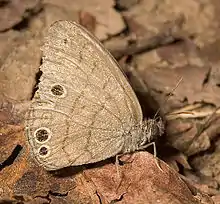Hermeuptychia sosybius
Hermeuptychia sosybius, the Carolina satyr, is a butterfly of the family Nymphalidae. It is found in the United States from southern New Jersey south along the coast to southern Florida, west to south-eastern Kansas, central Oklahoma and central Texas. It is also found in Mexico.
| Carolina satyr | |
|---|---|
_dorsal.jpg.webp) | |
 | |
| Scientific classification | |
| Kingdom: | Animalia |
| Phylum: | Arthropoda |
| Class: | Insecta |
| Order: | Lepidoptera |
| Family: | Nymphalidae |
| Genus: | Hermeuptychia |
| Species: | H. sosybius |
| Binomial name | |
| Hermeuptychia sosybius | |
| Synonyms | |
| |
The wingspan is 32–38 mm. The upperside is brown without markings. The underside is also brown, but with small eyespots rimmed with yellow on both wings. They feed on sap and rotting fruit.[3][4]

Its larvae can feed upon the highly-invasive Japanese stilt grass Microstegium vimineum,[5] so populations of this butterfly are potentially at risk from efforts to remove stilt grass. The endangered Mitchell's Satyr Neonympha mitchellii is also able to feed upon stilt grass.[6][7]
The larvae also feed on various Poaceae species, including Axonopus compressus, Eremochloa ophiuroides, Stenotaphrum secundatum and Poa pratensis.
References
| Wikimedia Commons has media related to Hermeuptychia sosybius. |
- "NatureServe Explorer 2.0 - Hermeuptychia sosybius Carolina Satyr". explorer.natureserve.org. Retrieved 27 September 2020.
- "Hermeuptychia Forster, 1964" at Markku Savela's Lepidoptera and Some Other Life Forms
- Butterflies and Moths of North America collecting and sharing data about Lepidoptera
- Life history of H. sosybius. USA: TX: Brazoria County, Bar-X Ranch, Rd. 971N, 29.13252 -95.58340, ex ovum ex ? collected on 4-Mar-2000, except o, which is TX: Wise Co., LBJ National Grassland. an ovum, 6-Mar-2000 b–d 1st instars, photographed on 14- 14- & 16-Mar-2000, respectively e–g 2nd instars photographed on 21- 19- & 21-Mar-2000 e, f are just after molt, shed larval skins are behind and 1st instar head capsule (black) is on the left in e, f is in a curled position adopted when disturbed h pre-molt quiescent 2nd instar larvae in a typical “head-to-head” resting position, 24-Mar-2000 i–j 3rd instars, 24- & 27-Mar- 2000 k–l 4th (ultimate) instars, ??, 3- & 6-Apr-2000 l close to pupation, note the color and shape change m prepupa, 6-Apr-2000 n–p pupae, 9-Apr-2000, 8-Aug-1998, & 17-Apr-2000 o is from Wise Co., wing color is starting to develop p near eclosion, dark adult is seen through semi-transparent pupal cuticle. Most images show different individuals. Images a–g are enlarged 2 times (scale on f) compared to the rest (scale on l)
- "Butterflies of North Carolina". NC Parks Service. Retrieved 2017-12-06.
- "Mitchell's Satyr". USF Water Institute. Retrieved 2017-12-06.
- "Host and Nectar Plants". USF Water Institute. Retrieved 2017-12-06.
